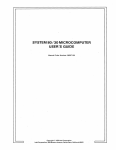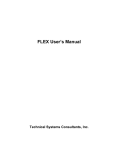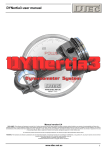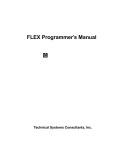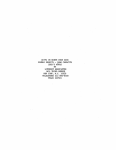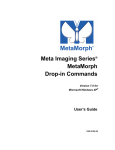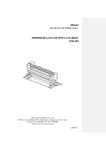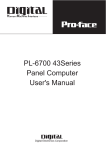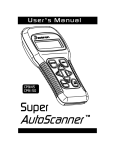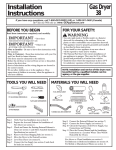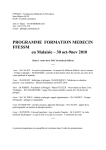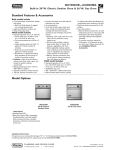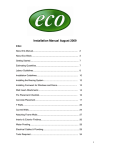Download A T T E N T I O N Know Your Computer and Be
Transcript
ATTENTION Know Your Computer and Be Sure You Are Using the Correct Software SWTPC has offered, or is now offering, three types of 6809 computers. In order to make SWTPC supplied software work correctly it is necessary to recognize what type of computer you have. Below is a description of each of the three types and some of the characteristics of each. The nomenclature for the motherboard of each type of computer is printed on the motherboard for easy identification. /09 The /09 computer is any SWTPC 6809 computer which uses an MP-B or MP-B2 motherboard. This computer uses the single port MP-S serial interface and the MP-L and MP-LA parallel interfaces. This computer can have up to 56K of 4K, 8K, 16K and 32K memory boards. Its chassis RESET button is on the right side of the front panel. 69A and 69K The 69A and 69K computers use the MP-B3 motherboard. The 69A and 69K are identical except that the A is factory.assembled and the K is the kit version. Each interface port in this type computer requires 16 addresses and uses the MP-S2 serial and MP-L2 parallel interface boards. This computer can have up to 56K of 4K, 8K, 16K and 32K memory boards. Its chassis RESET button is on the left side of the front panel. S/09 The S/09 computer uses the MP-MB motherboard. Each interface port in this computer requires 16 addresses and uses the MP-S2 serial and MP-L2 parallel interfaces. This computer also contains a standard parallel output port and an integral interrupt timer on the MP-ID board. The S/09 can use up to 384K of 128K memory array boards. Its chassis RESET button is on the left side of the front panel. Be Sure To Use The Correct Software Although the /09, 69A, 69K and S/09 computers are all basically the same, small differences in I/O port assignments, speed, features and memory types dictate that certain programs, such as printer drivers, function differently on the various models. After booting the system diskette, FLEX will automatically configure the operating system as completely as it can to certain initial values of speed, CPU type, etc. A special utility (SBOX) has been supplied to examine and change the initial values and computer type. After booting the supplied diskette, this utility should be run to be sure that ALL of the displayed characteristics match EXACTLY with the computer being used. Any necessary changes can be made using the SBOX utility. This will usually be necessary only on 109 computers and 69A/69K computers operating at 2 MHZ. SWTPC MODIFICATION--APPLICATION NOTICE AN #113 Product: FLEX 2.6 DOS Date: February 26, 1980 Configuring FLEX 2.6 for Computers with MP-B3 Motherboards (69A, 69K computers, not S/09 Computers) FLEX 2.6 may incorrectly auto configure on computers with MP-B3 motherboards by indicating the presence of an internal interval timer. This can be checked by running the SBOX utility contained on the FLEX 2.6 disk. If the utility responds with: -- Interval Timer = Yes then the SBOX utility must be used to set the Interval Timer response to NO. This must be done even if the system has an optional MP-T interrupt timer plugged on to the system. The timer configurator of the SBOX utility is concerned with the presence of the 6840 type timer which is standard on S/09 computers rather than the optional MP-T timer board. S/09 computers are the only ones at the time of this writing that should respond with "Interval Timer = Yes" response. To set the Interval Timer response to NO, enter the following: SBOX,TIMER=NO The SBOX command will change and confirm that the timer parameter has been properly set. +++SBOX SWTPC Configurator -- Version 2.1 -- Memory Size = __K -- I/O Port Size = 16 -- CPU Clock Rate = 1 MHz -- Power Line Frequency = __Hz -- Extended Addressing = No -- Interval Timer = No -- Real Time Clock = No -- Upper Case Only = Yes If the Interval Timer parameter is not properly set as outlined above the P command and printer spooling will not function correctly. - 1 - General Notes Technical Systems Consultants, Inc. GENERAL NOTES This section contains suggestions on getting FLEX™ 9.0 up on your system and on compatibility with your existing hardware and software. This manual assumes you already have a working disk system and are familiar with the basics of floppy disk systems such as proper disk handling techniques, inserting and removing disks from the drives, etc. One important point should be made in regard to getting FLEX "up and running". You receive only one disk and it is crucial that you protect this disk with your life. If you take the following steps, you might save yourself a lot of headaches and additional expense: 1) Write-protect the FLEX disk before you ever insert it into a drive. Consult your disk system hardware manual or the FLEX User's Manual for details on write-protecting a disk. 2) Boot up the FLEX system and once running copy all files from the original FLEX disk to a new disk. Next perform a LINK command to FLEX.SYS on this new disk. 3) Now remove the original FLEX disk and store it in a safe place. It should never be used again unless you wipe out all the new FLEX disks you make and need to repeat this procedure. Use the new FLEX disk you have made for all future disk work. FLEX™ is a trademark of Technical Systems Consultants, Inc. -1- FLEX General Notes HARDWARE REQUIREMENTS This section discusses the hardware requirements for running FLEX 9.0. This version is setup for th6 Southwest Technical Products Corporation's disk systems: the MF-68 or MF-69 5-inch minidiskette, the DMAF1 or DMAF2 8-inch diskette, and the CDS-1 Winchester disk unit. Memory Requirements The FLEX disk operating system itself resides in the range of $C000 to $DFFF. This means you will need 8K of memory starting at $C000. You should be certain your particular system can accept memory in this region. You must also have "User Memory" (RAM) starting at location $0000 and running continuously up from there. The more user memory you have in your system the better off you will be. This is because you will be able to run larger Programs and because software which works with files that are larger than memory can hold (such as the editor or sort/merge) will operate more efficiently and quickly. Although FLEX resides at $C000, certain of its commands utilize the lower end of this user RAM space. A minimum of 12K of RAM is required for such purposes. Monitor ROM As sold, this version of FLEX requires the S-BUG monitor ROM from SWTPc (or equivalent). FLEX 9.0 has its own internal terminal I/O routines, so S-BUG's are not used. These routines assume an ACIA at location $E004. S-BUG is required, however, for setting up interrupt vectors. There are two exceptions to this ROM requirement. The first is that the interrupt vectors need not be set if no program will use interrupts. Note that many programs such as printer spooling, the SWTPc Editors, etc., do make use of interrupts. Thus if you did not require printer spooling or editing you would not require any monitor ROM at all except for booting the system up and to jump to when exiting FLEX. The second exception is to make use of the user adaptable version of FLEX which is supplied on disk along with the standard version. See 'Adapting FLEX to Custom Monitors' for details. Printer Spooling FLEX 9.0 Version 2.6 supports printer spooling which allows you to list a file (or files) on a line printer at the same time as you perform other FLEX operations such as editing, assembling, running BASIC, etc. In order to do this, FLEX requires an S/09 computer system, or an MP-T interrupt timer board on I/O port #5 for /09, 69/A and 69/K computer systems. -2- FLEX General Notes DISK COMPATIBILITY Disks created under 6809 FLEX 9.0 are compatible with those created under 6800 FLEX 1.0 on the 8" drives or 6800 FLEX 2.0 on the 5" drives. The reverse is also true, meaning that FLEX 9.0 can read disks created by one of those 6800 FLEX systems. This means that transferring text files will require nothing more than copying with the COPY command. In fact it is not even necessary to put the files on a new disk. As long as a disk is being used for work files only (no disk command files) it may be used interchangeably. The one place where the disks are different is in the bootstrap loader which the NEWDISK command places on track 0 when a disk is initialized. Obviously the loader must be different for 6800 and 68C9. This simply means that a disk initialized with the 6809 NEWDISK command cannot be used to boot 6800 FLEX and vice versa. The new double-density system is an exception to all the above. It cannot be used to read disks created by the original 6800 single-density svstem. Any disks, however, created as single-density with the new double-density version of NEWDISK (done by answering 'N' to the prompt 'Double-Sided Disk?') can be read on either a single or double density system. This is because the new double-density NEWDISK writes FF's in certain gap areas whereas the old single-density NEWDISK wrote 00's. The single-density controller board (which uses the Western Digital 1771) can read either type, but the double-density board (which uses the Western Digital 1791) can only read the type with FF's. SOFTWARE COMPATIBILITY 6809 object code is NOT at all compatible with 6800 object code. This means you cannot run binary command files from a 6800 system on a 6809 system. Since 6809 FLEX can read a 6800 FLEX disk and vice versa you must be careful not to execute a 6800 command in a 6809 system and again, vice versa. Where the 6809 and 6800 ARE compatible is in the source code. Thus, if you have the source listing for a 6800 program on disk, it can be reassembled by the 6809 assembler to produce executable 6809 object code. Of course if the program calls any routines from FLEX, these addresses will have to be changed since 6809 FLEX resides at $C000 (6800 FLEX is at $A000). This is usually a matter of simply changing all occurrences of '$A' to '$C' and all '$B' to '$D' with the editor. -3- FLEX General Notes ADAPTING FLEX The FLEX 9.0 disk supplied has two copies of the FLEX object code. One is called FLEX.SYS and is ready to boot up with SWTPc disk hardware. The second is called FLEX.COR which represents the CORe or main body of FLEX. It differs from the bootable form of FLEX in that it does not have any terminal or disk I/O routines built in. This allows the user to modify these I/O drivers, if desired, to produce a customized version of FLEX. Note that in order to produce this customized version you must have FLEX up and running so you will need the bootable version (FLEX.SYS). The customized terminal and disk I/O routines are supplied in two packages. We will discuss them separately and then examine how to add them onto FLEX.COR to produce a new, customized, bootable version of FLEX. The CUSTOM I/O DRIVER PACKAGE This package allows the user to alter the functioning of the terminal I/O and the functioning of printer spooling. Nine routines and two interrupt vectors are set up in this package. There is a space reserved for these routines beginning at location $D370 and ending at $D3E6. The address of these 11 items must be setup in a jump table found at locations $D3E7 thru $D3FB. A copy of the Custom I/O Driver Package used to produce FLEX.SYS is included at the end of the General Notes section. Use it as a guide for writing your own. A description of each routine and vector follows. INCH The address of the input character routine should be placed at $D3FB. This routine should get one input character from the terminal and return it in 'A' with the parity bit cleared. It should also echo the character to the output device. Only 'A' and the condition codes may be modified. OUTCH The address of the output character should be placed at $D3F9. This routine should output the character found in 'A' to the output device. No registers should be modified except condition codes. STAT The address of the STAT routine should be placed at $D3F7. This routine checks the status of the input device. That is to say, it checks to see if a character has been typed on the keyboard. If so, a Not-Equal condition should be returned. If no character has been typed, an Equal to zero condition should be returned. No registers may be modified except condition codes. TINIT The address of the terminal initialization routine should be placed at $D3F5. This routine performs any necessary initialization for terminal I/O to take place. Any register may be modified except 'S'. -4- FLEX General Notes MONITR This is the address to which execution will transfer when FLEX is exited. It is generailly the reentry point of the system's monitor ROM The address should be placed at $D3F3. TMINT The address of the timer initialization routine should be placed at $D3F1. This routine performs any necessary initialization for the interrupt timer used by the printer spooling process. Any register may be modified except 'S'. TMON The address of the timer on routine should be placed at $D3EF. This routines "turns the timer on" or in other words starts the interval IRQ interrupts. Any registers execpt 'S' may be modified. TMOFF The address of the timer off routine should be placed at $D3ED. This routine "turns the timer off" or in other words stops the interval IRQ interrupts. Any registers except 'S' may be modified. IRQVEC The IRQ vector is an address of a two byte location in RAM where FLEX can stuff the address of its IRQ interrupt handler routine. In other words, when an IRQ interrupt occurs control should be transferred to the address stored at the location specified by the IRQ vector. This IRQ vector location (address) should be placed at $D3EB. SWIVEC The SWI3 vector is an address of a two byte location in RAM where FLEX can stuff the address of its SWI3 interrupt handler routine. In other words, when an SWI3 interrupt occurs control should be transferred to the address stored at the location specified by the SWI3 vector. This SWI3 vector location (address) should be placed at $D3E9. IHNDLR The Interrupt Handler routine is the one which will be executed when an IRQ interrupt occurs. If using printer spooling, the routine should first clear the interrupt condtion and then jump to the 'change process' routine of the printer spooler at $C700. If not using printer spooling. this routine can be setup to do whatever the user desires. If it is desirable to do both printer spooling and have IRQ's from another device (besides the spooler clock), this routine would have to determine which device had caused the interrupt and handle it accordingly. The address of this routine should be placed at $D3E7. -5- FLEX General Notes The CUSTOM DISK DRIVER PACKAGE This package supplies all the disk functions required by FLEX. are eight routines in all: READ WRITE VERIFY RESTORE DRIVE CHECK QUICK INIT WARM There Reads a single sector Writes a single sector Verifys a single sector Restores the head to track 0 Selects the desired drive Checks a drive for a ready condition Same as CHECK but with no delay Initializes any necessary values Does any Warm Start initialization These routines and what is required of them are decribed in the Advanced Programmer's Guide in the section titled 'DISK DRIVERS'. There is a jump table which contains the address of all these routines at $DE00. This table is as follows: DE00 DE03 DE06 DE09 DE0C DE0F DE12 DE15 DE18 JMP JMP JMP JMP JMP JMP JMP JMP JMP READ WRITE VERIFY RESTOR DRIVE CHECK QUICK INIT WARM Immediately following this jump table there is a space for the disk driver routines. In the general case this space would start at $DE1B and run through $DFFF. In the SWTPc system with S-BUG installed, that entire space is not available due to the fact that S-BUG uses RAM in the area of $DFA0 to $DFFF for variables and stack. Thus the driver routine area is limited in this case to $DE18 through $DF9F. The actual source listings for the SWTPc drivers are not included, but a skeletal Custom Disk Driver Package is included at the end of this section which should assist you in writing your own package. PUTTING THE CUSTOM FLEX TOGETHER Once you have written and assembled a Custom I/O and Custom Disk Driver packages, you are ready to append them to the core of FLEX (FLEX.COR) to produce a new, bootable version. This is done with the APPEND utility if FLEX, but before we get into that there is a very important point which must be covered. *** IMPORTANT *** -6- FLEX General Notes The copy of FLEX on disk is much like any other standard binary file. IT MUST HAVE A TRANSFER ADDRESS IN ORDER TO WORK! It is also important to note that unlike other binary files FLEX can have ONLY ONE transfer address and it MUST BE THE LAST THING IN THE FILE! The simplest way of getting that transfer address into the file is by use of the END statement in the assembler. We recommend you put a transfer address on the END statement of the Custom I/O Driver Package and make sure it is the last thing in the final FLEX file. Assuming you have put a transfer address Package with an end statement of the form: on the Custom I/O Driver END $CD00 You can now create a new version of FLEX by appending the custom disk drivers and custom I/O drivers onto FLEX.COR. You should use the APPEND command for this purpose as shown: +++APPEND FLEX.COR DRVRS.BIN CUSTOMIO.BIN NEWFLEX.SYS This command assumes the object file you created for the Custom Disk Drivers is called DRVRS.BIN and the Custom I/O Drivers are in a file called CUSTOMIO.BIN. The new, custom version of FLEX is called NEWFLEX.SYS. In order to boot up this NEWFLEX.SYS you must link it with the LINK command (see the FLEX User's and Advanced Progammer's Manuals). The command would be of the form: +++LINK NEWFLEX.SYS The disk containing your newly made and linked FLEX can now be booted with the normal boot, procedure. -7- SKELETAL DISK DRIVER PACKAGE 7-18-79 TXC 6809 XASMB * * * * * SKELETAL 6809 DISK DRIVER PACKAGE TECHNICAL SYSTEMS CONSULTANTS, INC. BOX 2574 WEST LAFAYETTE, INDIANA 47906 * * * * * * * * * * * * * * * * * THE 1. 2. 3. 4. 5. 6. 7. 8. 9. PAGE 1 DRIVER ROUTINES PERFORM THE FOLLOWING READ SINGLE SECTOR - DREAD WRITE SINGLE SECTOR - DWRITE VERIFY WRITE OPERATION - VERIFY RESTORE HEAD TO TRACK 00 - RESTORE DRIVE SELECTION - DRIVE CHECK READY - DCHECK QUICK CHECK READY - DQUICK COLD START INITIALIZATION - DINIT WARM START INITIALIZATION - DWARM SYSTEM CONSTANTS THIS SPACE IS WHERE ANY NECESSARY EQUATES MIGHT BE PLACED, SUCH AS DISK CONTROLLER REGISTER LOCATIONS, SECT0R LENGTH, ETC. ****************************************************** DE00 ORG $DE00 * JUMP TABLE DE00 DE03 DE06 DE09 DE0C DE0F DE12 DE15 DE18 7E 7E 7E 7E 7E 7E 7E 7E 7E DE23 DE28 DE2D DE31 DE35 DE39 DE3F DE1B DE1F DREAD DWRITE DVERFY RESTOR DRIVE DCHECK DQUICK DINIT DWARM JMP JMP JMP JMP JMP JMP JMP JMP JMP READ WRITE VERIFY RST DRV CHECK QUICK INIT WARM ******************************************************* SKELETAL DISK DRIVER PACKAGE 7-18-79 TXC 6809 XASMB PAGE 2 ******************************************************** * VARIABLE STORAGE * * * * IF ANY VARIABLES ARE REQUIRED, THEY MIGHT BE PLACED HERE. THIS MIGHT INCLUDE VARIABLES LIKE CURRENT DRIVE, CURRENT TRACK FOR EACH DRIVE, OR TEMPORARY STORAGE LOCATIONS. ************************************************ * INIT * * INITIALIZES THE NECESSARY DRIVER VARIABLES. DE1B DE1C DE1D DE1E 12 12 12 39 INIT NOP NOP NOP RTS THIS ROUTINE IS CALLED DURING FMS INITIALIZATION AT COLD START * WARM * * WARM START INITIALIZATION DE1F DE20 DE21 DE22 12 12 12 39 WARM NOP NOP NOP RTS THIS ROUTINE IS CALLED DURING FMS INITIALIZATION AT WARM START * READ * * READ ONE SECTOR DE23 DE24 DE25 DE26 DE27 12 12 12 12 39 READ NOP NOP NOP NOP RTS READS THE SECTOR POINTED TO BY TRACK IN 'A' AND SECTOR IN 'B'. 'X' POINTS TO FCB. * WRITE * * WRITE ONE SECTOR DE28 DE29 DE2A DE2B DE2C 12 12 12 12 39 WRITE NOP NOP NOP NOP RTS WRITES THE SECTOR POINTED TO BY TRACK IN 'A' AND SECTOR IN 'B'. 'X' POINTS TO FCB. SKELETAL DISK DRIVER PACKAGE 7-18-79 TSC 6809 XASMB PAGE 3 * VERIFY * * VERIFY LAST TRACK WRITTEN DE2D DE2E DE2F DE30 12 12 12 39 VERIFY NOP NOP NOP RTS THE SECTOR JUST WRITTEN IS VERIFIED. NO PARAMETERS ARE SUPPLIED. * RST * * RST RESTORES THE HEAD TO 00 DE31 DE32 DE33 DE34 12 12 12 39 RST NOP NOP NOP RTS HEAD RESTORED TO TRACK ZERO ON DRIVE POINTED TO BY FCB AT 'X'. * DRV * * DRV SELECTS THE DRIVE. DE35 DE36 DE37 DE38 12 12 12 39 DRV NOP NOP NOP RTS THE DRIVE NUMBER FOUND IN FCB POINTED TO BY 'X' IS SELECTED. * CHECK * * CHECK FOR DRIVE READY DE39 DE3A DE3B DE3C DE3D DE3E 12 12 12 12 12 39 CHECK NOP NOP NOP NOP NOP RTS THE DRIVE POINTED TO BY FCB AT 'X' IS CHECKED FOR A READY STATE AFTER DELAYING FOR DRIVES TO COME UP TO SPEED. * QUICK * * QUICK CHECK FOR READY DE3F DE40 DE41 DE42 DE43 DE44 12 12 12 12 12 39 QUICK NOP NOP NOP NOP NOP RTS END THE DRIVE POINTED TO BY FCB AT 'X' IS CHECKED FOR READY STATE WITHOUT DELAYING FOR DRIVES TO COME UP TO SPEED. CUSTOM I/O DRIVER PACKAGE 7-18-79 TSC 6809 XASMB PAGE 1 * CUSTOM I/O DRIVER PACKAGE * * CONTAINS ALL TERMINAL I/O DRIVERS AND INTERRUPT * * SYSTEM EQUATES C700 EQU $C700 CHANGE PROCESS ROUTINE ******************************************************* * * * I/O ROUTINE VECTOR TABLE * * * ORG $D3E7 TABLE STARTS AT $D3E7 * * * IHNDLR FDB IHND IRQ INTERRUPT HANDLER * SWIVEC FDB $DFC2 SWI3 VECTOR LOCATION * IRQVEC FDB $DFC8 IRQ VECTOR LOCATION * TMOFF FDB TOFF TIMER OFF ROUTINE * TMON FDB TON TIMER ON ROUTINE * TMINT FDB TINT TIMER INITIALIZATION ROUTINE * MONITR FDB $F814 MONITOR RETURN ADDRESS * TINIT FDB INIT TERMINAL INITIALIZATION * STAT FDB STATUS CHECK TERMINAL STATUS * OUTCH FDB OUTPUT TERMINAL CHAR OUTPUT * INCH FDB INPUT TERMINAL CHAR INPUT * * * ******************************************************* D3E7 DEE7 D3E9 D3EB D3ED D3EF D3F1 D3F3 D3F5 DEF7 DEF9 D3FB CHPR D3CB DFC2 DFC8 D3C4 D3BD D3A7 F814 D370 D39C D38B D37D * ACTUAL ROUTINES START HERE ****************************** D370 ORG $D370 * TERMINAL INITIALIZE ROUTINE D370 D372 D376 D378 D37C 86 A7 86 A7 39 13 9F D3E5 11 9F D3E5 INIT LDA STA LDA STA RTS #$13 #$11 RESET ACIA [ACIAC] CONFIGURE ACIA [ACIAC] * TERMINAL INPUT CHARACTER ROUTINE D37D D381 D383 D385 D389 A6 84 27 A6 84 9F D3E5 01 F8 9F D3E3 7F INPUT LDA ANDA BEQ LDA ANDA [ACIAC] #$01 INPUT [ACIAD] #$7F GET STATUS CHARACTER PRESENT? LOOP IF NOT GET THE CHARACTER STRIP PARITY CUSTOM I/O DRIVER PACKAGE 7-18-79 TSC 6809 XASMB PAGE * TERMINAL OUTPUT CHARACTER ROUTINE 2 D38B D38D D391 D393 D395 D397 D39B 34 A6 84 27 35 A7 39 02 9F D3E5 02 F8 02 9F D3E3 OUTPUT OUTPU2 PSHS LDA ANDA BEQ PULS STA RTS A [ACIAC] #$02 OUTPU2 A [ACIAD] SAVE CHARACTER TRANSMIT BUFFER EMPTY? WAIT IF NOT RESTORE CHARACTER OUTPUT IT * TERMINAL STATUS CHECK (CHECK FOR CHARACTER HIT) D39C D39E D3A2 D3A4 D3A6 34 A6 84 35 39 02 9F D3E5 01 02 STATUS PSHS LDA ANDA PULS RTS A [ACIAC] #$01 A SAVE A REG. GET STATUS CHECK FOR CHARACTER RESTORE A REG. * TIMER INITIALIZE ROUTINE D3A7 D3AA D3AC D3AE D3B0 D3B2 D3B4 D3B6 D3B8 D3BA D3BC BE 86 A7 86 A7 86 A7 A6 86 A7 39 D3E1 FF 84 3C 01 8F 84 84 3D 01 TINT LDX LDA STA LDA STA LDA STA LDA LDA STA RTS TMP1A #$FF 0,X #$3C 1,X #$8F 0,X 0,X #$3D 1,X GET PIA ADDRESS * TIMER ON ROUTINE D3BD 86 D3BF A7 D3C3 39 04 9F D3E1 LDA STA RTS #$04 [TMPIA] TURN ON TIMER * TIMER OFF ROUTINE D3C4 86 D3C6 A7 D3CA 39 8F 9F D3E1 LDA STA RTS #$8F [TMPIA] TURN OFF TIMER * IRQ INTERRUPT HANDLER ROUTINE D3CB A6 D3CF 7E 9F D3E1 C700 IHND STA JMP [TMPIA] CHPR RESET INTERRUPTS GO TO SPOOLER CUSTOM I/O DRIVER PACKAGE 7-18-79 TSC 6809 XASMB PAGE * ACIA AND PIA ADDRESS FOR SUPPLIED ROUTINES D3E1 D3E1 E012 D3E3 E005 D3E5 E004 TMPIA ACIAD ACIAC ORG $D3E1 FDB FDB FDB $E012 $E005 $E004 TIMER PIA ADDRESS ACIA DATA REG. ADR. ACIA CONTROL REG. ADR. * END STATEMENT HAS FLEX TRANSFER ADDRESS! END $CD00 3
















